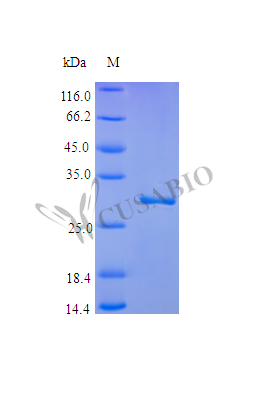Recombinant Human Plasminogen protein (PLG) , partial (Active)
CAT:
399-CSB-AP002261HU-03
Size:
500 µg
Price:
Ask
- Availability: 24/48H Stock Items & 2 to 6 Weeks non Stock Items.
- Dry Ice Shipment: No




Recombinant Human Plasminogen protein (PLG) , partial (Active)
- CAS Number: 9000-83-3
- Gene Name: PLG
- UniProt: P00747
- Expression Region: 98-356aa
- Organism: Homo sapiens
- Target Sequence: VYLSECKTGNGKNYRGTMSKTKNGITCQKWSSTSPHRPRFSPATHPSEGLEENYCRNPDNDPQGPWCYTTDPEKRYDYCDILECEEECMHCSGENYDGKISKTMSGLECQAWDSQSPHAHGYIPSKFPNKNLKKNYCRNPDRELRPWCFTTDPNKRWELCDIPRCTTPPPSSGPTYQCLKGTGENYRGNVAVTVSGHTCQHWSAQTPHTHNRTPENFPCKNLDENYCRNPDGKRAPWCHTTNSQVRWEYCKIPSCDSSP
- Tag: Tag-Free
- Source: E.Coli
- Field of Research: Cancer
- Assay Type: Active Protein & In Stock Protein
- Relevance: Plasmin dissolves the fibrin of blood clots and acts as a proteolytic factor in a variety of other processes including embryonic development, tissue remodeling, tumor invasion, and inflammation. In ovulation, weakens the walls of the Graafian follicle. It activates the urokinase-type plasminogen activator, collagenases and several complement zymogens, such as C1 and C5. Cleavage of fibronectin and laminin leads to cell detachment and apoptosis. Also cleaves fibrin, thrombospondin and von Willebrand factor. Its role in tissue remodeling and tumor invasion may be modulated by CSPG4. Binds to cells. {ECO:0000269|PubMed:14699093}.; Angiostatin is an angiogenesis inhibitor that blocks neovascularization and growth of experimental primary and metastatic tumors in vivo. {ECO:0000269|PubMed:14699093}.
- Endotoxin: Less than 1.0 EU/µg as determined by LAL method.
- Purity: >95% as determined by SDS-PAGE.
- Activity: Yes
- Bioactivity: Fully biologically active when compared to standard. The specific activity determined by an assay on anti-proliferation and anti-migration using endothelial cells in vitro and anti-angiogenesis in vivo is 5.5 × 105 IU/mg.
- Length: Partial
- Form: Lyophilized powder
- Buffer: Lyophilized from a 0.2 μm filtered 20 mM NaAc, pH 5.5, 4 % mannitol
- Reconstitution: We recommend that this vial be briefly centrifuged prior to opening to bring the contents to the bottom. Please reconstitute protein in deionized sterile water to a concentration of 0.1-1.0 mg/mL.We recommend to add 5-50% of glycerol (final concentration) and aliquot for long-term storage at -20℃/-80℃. Our default final concentration of glycerol is 50%. Customers could use it as reference.
- Function: Plasmin dissolves the fibrin of blood clots and acts as a proteolytic factor in a variety of other processes including embryonic development, tissue remodeling, tumor invasion, and inflammation. In ovulation, weakens the walls of the Graafian follicle. It activates the urokinase-type plasminogen activator, collagenases and several complement zymogens, such as C1 and C5. Cleavage of fibronectin and laminin leads to cell detachment and apoptosis. Also cleaves fibrin, thrombospondin and von Willebrand factor. Its role in tissue remodeling and tumor invasion may be modulated by CSPG4. Binds to cells.
- Molecular Weight: 29.7 kDa
- Storage Conditions: The shelf life is related to many factors, storage state, buffer ingredients, storage temperature and the stability of the protein itself. Generally, the shelf life of liquid form is 6 months at -20℃/-80℃. The shelf life of lyophilized form is 12 months at -20℃/-80℃.
